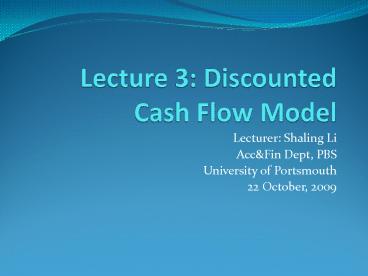Lecture 3: Discounted Cash Flow Model
1 / 22
Title:
Lecture 3: Discounted Cash Flow Model
Description:
Lecture 3: Discounted Cash Flow Model Author: yoana Last modified by: ... Discounted Cash Flow Model Re-cap from last week Structure of this lecture Why use models? – PowerPoint PPT presentation
Number of Views:17
Avg rating:3.0/5.0
Title: Lecture 3: Discounted Cash Flow Model
1
Lecture 3 Discounted Cash Flow Model
- Lecturer Shaling Li
- AccFin Dept, PBS
- University of Portsmouth
- 22 October, 2009
2
Re-cap from last week
Real world UK London exchange
Theoretical world Rationality Frictionless
market Liquidity Government role Models, results
3
Structure of this lecture
- Nutshell of the Discounted Cash Flow (DCF)model
- Key definitions
- Modelling
- Applications
4
Why use models?
- They are easy to understand representations of
something we cannot normally see. - Advantages
- Simplification of complex problems
- Scientific understanding of performance and
fundamental Limits - Simulations of systems
- Disadvantages
- Depends on the reliability of assumptions
- Cannot explain everything, has limitations
5
Nutshell of this model
Input
Output
6
Key definitions
- Time value of money
- The value of money earns a given amount of
interest over a given amount of time - Example 100 of today's money invested for one
year and earning 5 interest will be worth 105
after one year. - Todays 100 is more valuable than tomorrows
100 - Interest rate (i)
- A measure of time value of money
- Example 5
7
Key definitions
- Present value (PV)
- Present value is the value on a given date of a
future payment or series of future payments,
discounted to reflect the time value of money and
other factors. - Example what is the present value of 100 one
year later with interest rate 5? (Answer
95.24) - Future value (FV)
- Future value measures the nominal future sum of
money that a given sum of money is "worth" at a
specified time in the future assuming a certain
interest rate. - Example what is the future value of 100 in one
year time with interest rate 5? (Answer 105)
8
A very basic example
FV
PV
9
Discounted Cash Flow Model
- More complexity added
- Single-period case to the multiple-period case
- Single cash flow to multiple of cash flows
10
Complexity added-1
- The single-period case to the multiple-period
case - Example 100 of today's money invested for one
year and earning 5 interest will be worth 105
after one year. - Example 100 of today's money invested for three
years and earning 5 interest will be worth ???
after three years. - Simple interest method 100 31005 115
- Compounding interest method 100(15)3115.76
11
PV with compounding interest
- 0 1
2 3 4
5
FV
PV
12
Complexity added-2
- Future values (FV) of multiple of cash flows
- Example Invest 100 of today's money invested
for first year, 150 in the beginning of the
second year and 300 in the beginning of the
third year, earning 5 interest. What would be
the future value in the beginning of third year. - Future value 100(15)3 150(15)2300(15
) 596.14 - 0 1 2
3
100
150
300
13
Complexity added-2
- Present values (PV)of multiple of cash flows
- Example Receive 100 in the end of the first
year, 150 in the end of the second year and 300
in the end of the third year, earning 5
interest. What would be the present value of
today. - Present value 100/(15)150/(15)2300/(15)
3 490.44 - 0 1 2
3
300
150
100
14
The full DCF model
- 0 1
2 3 4
5
FV
PV
15
PV with multiple cash flows
- If there is a perpetual cash flow (in theory),
how to calculate the present value? - C constant cash flow in an unlimited years in
the future - i discount rate
16
Important issues
- Draw the timeline and cash flows
- Be careful with money flow point (in the
beginning or end of year t) - Be familiar with the simple model and the complex
one
17
Applications-Bond investment
- Bond should you buy the bond or not
- Here is the deal pay 977 to purchase the bond
with face value 1000 with 10 fixed interest
rate on the paper, matured in six years. - Calculate present value of all the future cash
flows
18
Applications-Bond investment
- The present value of the bond will depend on the
actual interest rate / discount rate (not the
fixed interest rate on the bond) - If actual interest rate is 8, PV1092, buy
- If actual interest rate is 10, PV1000, buy
- If actual interest rate is 12, PV917, not buy
19
Application-Stock investment
- Invest in a stock and receive dividend annually
(suppose perpetual cash flow) - Example, the price for one share of company ABC
is 250p per share and the dividend payout is 15p
per share. The discount rate is 5 - Present value of the perpetual annual dividend
income is 15/0.05300p - Current price is 250p
- Conclusion Buy
20
How to calculate it with Excel
21
Important issues
- Bond investment
- How to know the interest rate/discount rate?
- Stock investment
- How to know the future cash flow?
- How to know the discount factor?
- There are the gaps between theory and real world.
22
Summary
- Why use model to describe the real world?
- Key definitions to understand DCF model
- Basic model
- Complexity added to the model
- Application Bond and Stock investment































